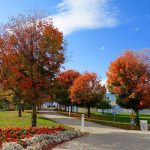Welcome to the inaugural post of our “Green Dreams: Crafting Your Perfect Outdoor Space” series. Landscape design is both an art and a science, aimed at creating functional and aesthetically pleasing outdoor living spaces. A well-thought-out design is essential to achieving a garden that not only mirrors your personal style but also caters to your practical needs. Let’s dive into the fundamentals of landscape design and embark on a journey to transform your outdoor space into a haven of beauty and tranquility.
Understanding Landscape Design Principles
At the core of every stunning garden are the basic principles of landscape design: balance, contrast, unity, scale, and proportion. These principles are the guideposts for creating harmonious outdoor spaces that invite relaxation and enjoyment. Whether it’s achieving balance through symmetrical plantings or adding interest with contrasting textures, each principle plays a pivotal role in the garden planning process.
Setting Goals and Assessing Needs
Defining clear objectives for your landscape project is crucial. Are you envisioning cozy entertaining spaces, vibrant play areas, or serene relaxation zones? Assessing your outdoor space’s needs involves considering privacy, maintenance, and the local climate. Establishing your goals early on guides the design process, ensuring your outdoor space fulfills your desires.
Choosing a Design Theme
Selecting a theme for your landscape design helps create a cohesive look and feel. Whether you’re drawn to the elegance of formal gardens, the charm of cottage styles, or the sleek lines of modern landscapes, choosing a theme that complements your home’s architecture and reflects your personal taste is key. Tips for theme selection include drawing inspiration from your home’s existing style and considering the themes of neighboring landscapes for continuity.
Site Analysis and Planning
A thorough site analysis lays the groundwork for successful landscape design. This step involves evaluating soil conditions, sunlight patterns, topography, and existing vegetation. Understanding these elements is crucial for determining the optimal placement of plants, paths, and water features, ensuring that every aspect of your design thrives and complements the overall aesthetic.
Plant Selection and Placement
Plants are the heart of any garden, bringing life, color, and texture to your outdoor space. Selecting plants that suit your garden’s conditions and adhere to your design theme is essential. The mantra “right plant, right place” emphasizes the importance of choosing plants that will thrive in their designated spots, reducing the need for excessive maintenance.
Hardscaping Elements
Hardscaping elements like patios, walkways, walls, and fences add structure and usability to your garden. These features should be selected to fit the landscape’s style and withstand local weather conditions. Whether you’re incorporating a winding stone path or a sleek, modern fence, hardscaping elements are integral to the functionality and aesthetic appeal of your outdoor space.
Creating Outdoor Living Areas
Outdoor living areas are extensions of your home, offering spaces for dining, relaxation, and entertainment. Integrating comfortable furniture, shade structures, and lighting makes these areas inviting and functional. From cozy fire pits to expansive decks, these spaces enhance the enjoyment and usability of your garden.
Sustainability in Design
Incorporating sustainable practices into landscape design, such as water conservation techniques, native plantings, and organic gardening methods, benefits both the environment and homeowners. These eco-friendly approaches ensure your garden is not only beautiful but also sustainable in the long run.
Visualizing the Design
Visualizing your landscape design before implementation is invaluable. Tools like sketches, digital renderings, and landscape design software help bring your vision to life, allowing for informed decisions and necessary adjustments. This visual planning phase is crucial for ensuring your final garden meets your expectations.
Conclusion
Embarking on the landscape design process is an exciting journey. By understanding design principles, setting clear goals, and carefully planning each element, you can create an outdoor space that reflects your style and meets your needs. Remember, landscape design is a creative journey that transforms not just your garden but also your experience of home.
Ready to turn your green dreams into reality? Contact LTDNurseryLandscaping.com for expert guidance and services to make your landscape design dreams come true. Visit our portfolio for inspiration or reach out to schedule a consultation. Let us help you craft your perfect outdoor space.



